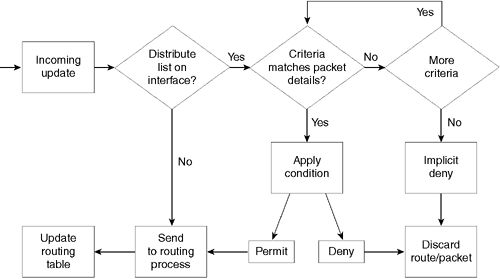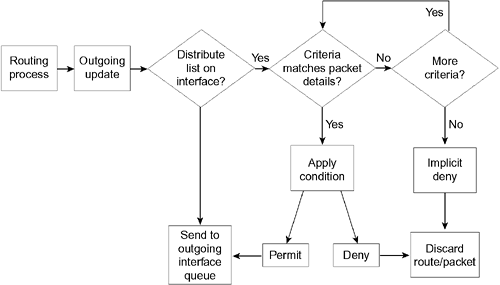| The "Foundation Summary" section of each chapter lists the most important facts from the chapter. Although this section does not list every fact from the chapter that will be on your exam, a well-prepared candidate should, at a minimum, know all the details in each "Foundation Summary" before going to take the exam. Various methods enable you to control the routing information sent between routers. These methods include the following: -
Passive interfaces An interface that does not participate in the routing process. In RIP and IGRP, the process listens but will not send updates. In OSPF and EIGRP, the process neither listens nor sends updates because no neighbor relationship can form. The interfaces that participate in the interior routing process are controlled by the interface configuration. During configuration, the routing process is instructed via the network command on which interfaces to use. Because most protocols express the networks at the major boundary, interfaces that have no reason to send this protocol's updates propagate the data across the network. This is not only a waste of bandwidth but, in many cases, can also lead to confusion. -
Default route A route used if there is no entry in the routing table for the destination network. If the lookup finds no entry for the desired network and no default network is configured, the packet is dropped. If the routing process is denied the right to send updates, the downstream routers will have a limited understanding of the network. To resolve this, use default routes. Default routes reduce overhead, add simplicity, and can remove loops . -
Static routes A route that is manually configured. It takes precedence over dynamic routes learned via a routing process. If no routing process is configured, static routes might be configured to populate the routing table. This is not practical in a large network because the table cannot learn of changes in the network topology dynamically. In small environments or for stub networks, however, this is an excellent solution. -
The null interface An imaginary interface that is defined as the next logical hop in a static route. All traffic destined for the remote network is carefully routed into a black hole. This can be used in a similar way as the passive interface, but it allows for greater granularity in the denied routes. It is also used to feed routes into another routing protocol. It allows another mask to be set and, therefore, is useful when redistribution occurs between a routing protocol that uses VLSM and one that does not. In this way, it aggregates routes as shown in the previous chapter. -
Distribute lists Access lists applied to the routing process, determining which networks will be accepted into the routing table or sent in updates. When communicating to another routing process, it is important to control the information sent into the other process. This control is for security, overhead, and management reasons. Access lists afford the greatest control for determining the traffic flow in the network. -
Route maps Complex access lists permitting conditional programming. If a packet or route matches the criteria defined in a match statement, changes defined in the set command are performed on the packet or route in question. Table 17-13 shows the requirements of automatic redistribution between routing protocols. Table 17-13. Automatic Redistribution Between Routing Protocols | Routing Protocol | Redistribution Policy | | Static | Requires manual redistribution into other routing protocols. | | Connected | Unless included in the network command for the routing process, requires manual redistribution. | | RIP | Requires manual redistribution. | | IGRP | Will automatically redistribute between IGRP and EIGRP if the autonomous system number is the same. Otherwise, processes with different IGRP autonomous system numbers, or IGRP and EIGRP processes with different autonomous system numbers , require manual redistribution. | | EIGRP | Will automatically redistribute between IGRP and EIGRP if the autonomous system number is the same. Otherwise, processes with different EIGRP autonomous system numbers, or IGRP and EIGRP processes with different autonomous system numbers, require manual redistribution. EIGRP for AppleTalk will automatically redistribute between EIGRP and RTMP. EIGRP for IPX will automatically redistribute between EIGRP and IPX RIP/ SAP; in later versions, NLSP can be manually redistributed. | | OSPF | Requires manual redistribution between different OSPF process IDs and routing protocols. | The following list explains the logic used in a distribute list: -
The router receives a routing update or is about to send a routing update about one or more networks. -
The router looks at the appropriate interface involved with the action to check for filtering. -
The router determines whether a filter is associated with the interface. -
If a filter is present, the router examines the access list to see if there is a match on any of the networks in the routing update. -
If there is no filter on the interface, the routing update is sent directly to the routing process, as normal. -
If there is a filter, the route entry is processed according to the distribute list: advertise the route if matched by a permit statement or do not advertise if it is matched by a deny statement. -
If no match is found in the distribute list, the implicit deny any at the end of the access list will cause the update to be dropped. Figure 17-12 shows the decisions that are made when a distribute list is applied to an incoming routing update, and Figure 17-13 shows the decisions made for an outgoing routing update. The logic used in a distribute list is similar to an access list and is summarized in the following chart. Refer to the section "Controlling Routing Updates with Filtering" for a detailed discussion of this subject. Figure 17-12. Distribute List Logic on an Incoming Update  Figure 17-13. Distribute List Logic on an Outgoing Update  |